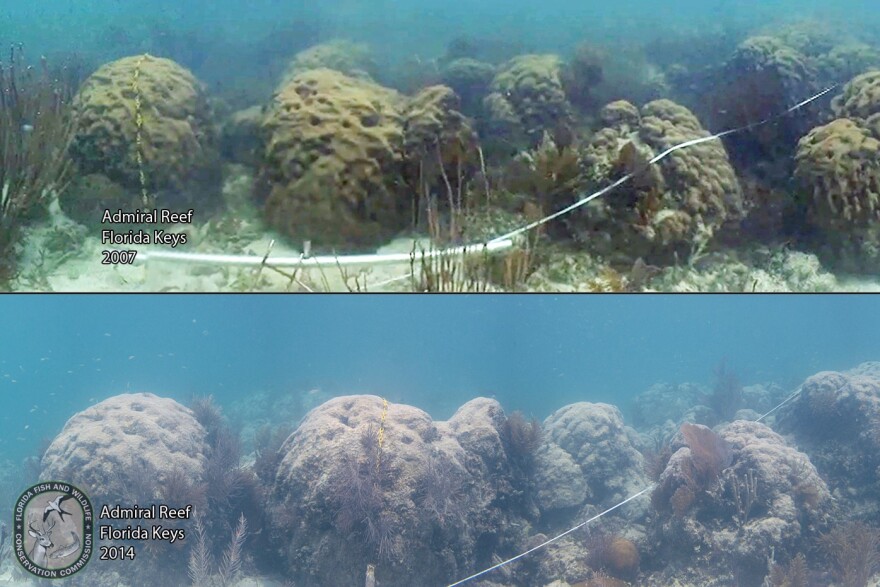Among the environmental programs on the chopping block under President Donald Trump’s proposed budget is a little-known grant program administered through the Environmental Protection Agency called the South Florida Geographic Initiative. The program funds efforts to monitor water quality in the Everglades and the Florida Keys as well as efforts to monitor the health of seagrasses and coral reefs. The proposed loss of that federal support has some environmental researchers in Florida on edge.
The South Florida Geographic Initiative provides grant funding for environmental monitoring efforts administered through the EPA’s Water Quality Protection Program. Among those efforts is the Florida Fish and Wildlife Conservation Commission’s Coral Reef Evaluation and Monitoring Program, or CREMP. Since 1996, that program has provided annual monitoring of 40 coral reef sites throughout the Florida Keys, making it the second longest ongoing coral reef monitoring program in the world. Since its inception, CREMP has relied on funds from the South Florida Geographic Initiative. Just since 2015, the program has received $540,000 dollars from the EPA grant program. Rob Ruzicka is a research administrator and the Florida Fish and Wildlife Conservation Commission’s Principal Investigator for CREMP. He said the EPA program is critical to his work.
“I would say the bulk of it, maybe 75 percent to 80 percent of it has been through the EPA,” said Ruzicka. “If the Geographic Initiative’s program was eliminated within the EPA that would basically cripple the CREMP program and we would not be able to carry on our monitoring like we do now.”
Ruzicka said the two decades of data collected through CREMP draw attention to a concerning trend in Florida’s coral health.
“We’ve seen a roughly 50 percent decline in the coral cover at our sites,” said Ruzicka. “And while this can’t necessarily be extrapolated throughout the entire Florida Keys and through the entire Florida reef tract, what we’ve seen within our monitoring sites is a large reflection on the amount of coral that we have lost.”
The South Florida Geographic Initiative also provides critical funds for a Florida Keys Water Quality Monitoring project and a Seagrass Monitoring Project, both administered through Florida International University researchers. For 20 years, it has also provided funding for efforts monitoring the threats of phosphorus, mercury and other elements that can damage the Everglades.
Data collected for the EPA through the initiative was also key in a 2012 federal court settlement in which U.S. District Judge Alan S. Gold ordered the state to spend $880 million on an Everglades clean-up plan.
In April, more than 30 members of Congress, including U.S. Rep. Carlos Curbelo, R-Kendall, sent a letter to President Trump urging federal support for the EPA’s Geographic programs throughout the country.
See below for a detailed list of projects funded in recent years through the EPA’s South Florida Geographic Initiative:
1. Florida Keys Coral Reef Evaluation and Monitoring Program – EPA funded $270,000 in 2015 and $270,000 in 2016:
The health of the coral reef ecosystem in the Florida Keys depends on the quality of water in which the corals live. Even a slight deterioration in water quality can be stressful to the reef. To collect valuable information about the reef ecosystem, scientists from the Florida Fish and Wildlife Conservation Commission began systematically monitoring coral reefs throughout Florida Keys National Marine Sanctuary in 1996. This research program, called the Coral Reef Evaluation and Monitoring Program (CREMP), studies various aspects of reef health at 40 sites throughout the sanctuary.
CREMP scientists look at the coral health as it relates to the quality of the water. Coral reef research and monitoring are especially important for tracking the effects of increasing seawater temperatures and sea level rise associated with the Earth’s changing climate.
2. Florida Keys Seagrass Monitoring Project – EPA funded $200,000 in 2015 and $200,000 in 2016; project lead is James W. Fourqurean, Ph.D., Marine Sciences Program, Florida International University
The general objective of seagrass monitoring in the Florida Keys National Marine Sanctuary (FKNMS) is to measure the status and trends of seagrass communities to evaluate progress toward protecting and restoring the living marine resources of the Sanctuary. The scope and depth of this monitoring effort are without precedent or peer for seagrass ecosystems throughout the world. Specific objectives are: 1) To provide data needed to make unbiased, statistically rigorous statements about the status and temporal trends of seagrass communities in the Sanctuary as a whole and within defined strata; 2) To help define reference conditions in order to develop resource-based water quality standards; and 3) To provide a framework for testing hypothesized pollutant fate/effect relationships through process-oriented research and monitoring. In order to meet these objectives, we have developed these goals for the project:
Define the present distribution of seagrasses within the FKNMS
Provide high-quality, quantitative data on the status of the seagrasses within the FKNMS
Quantify the importance of seagrass primary production in the FKNMS
Define the baseline conditions for the seagrass communities
Determine relationships between water quality and seagrass status
Detect trends in the distribution and status of the seagrass communities
More detail at: http://ocean.floridamarine.org/FKNMS_WQPP/seagrass.htm
3. Florida Keys Water Quality Monitoring Project – EPA funded $415,000 in 2015 and $450,000 in 2016; project lead is: Henry O. Briceño; Southeast Environmental Research Center, Florida International University
The Southeastern Environmental Research Program at Florida International University operates a network of 340 fixed sampling sites distributed throughout the estuarine and coastal ecosystems of south Florida. The purpose of this network is to address concerns in regional water quality that cross and overlap political boundaries. EPA funds the water quality monitoring within the FKNMS. Healthy and productive seagrass and coral communities require clean, clear water that is low in nutrients. This Keys program has monitored the water quality since 1995, and is part of this larger network of monitoring projects that includes Biscayne Bay, Florida Bay, Whitewater Bay, Ten Thousand Islands, Rookery Bay, Estero Bay, and Pine Island Sound.
More detail at: http://ocean.floridamarine.org/FKNMS_WQPP/waterQualityNew.htm
4. Special Projects – EPA funded $293,000 in 2015 and $250,000 in 2016. The following is a listing of the special projects that EPA funded in 2015 and 2016:
Florida Keys Water Watch Program – Monroe County working with Florida Extension; EPA funded $26,587 in 2016
- continued development of citizen monitoring program developed through a WQPP
- conducting monitoring/educational outreach within Monroe County
- strong leveraging of funds from other sources; >100% match
- new development, working with Lake Watch to collect nutrient samples
- working outside Sanctuary/Biscayne
- provide Best Management Practices messaging to homeowners
Assessment and mitigation of impacts from surface waters and land-based sources of endocrine disrupting compounds (EDCs) on water quality and coral reef communities of the Florida Keys - Mote Marine Laboratory and Nova University; EPA funded $112,830 in 2016
- scientific literature review of EDCs potentially impacting Keys, SE Reef Tract
- EDC monitoring at reefs, nearshore, canals, toxicity testing
- education and outreach, working with NSF RAPS program/research after school program for high school
- develop management strategies to mitigate EDC pollution
Improve Water Quality in Residential Canals Project – Monroe County; EPA funded $110, 582 in 2016
- reevaluate 306 canals not meeting Dissolved Oxygen (DO) standard; collect DO data and all fair and poor canals for confirmation
- collecting sediment cores for restoration potential and potential beneficial use of sediment
- develop conceptual designs for 15 canals
- one canal restoration project utilizing funding $1.7M from Monroe County
- significant leveraging of additional funds from other sources; >100% match
Everglades – funds go to the Everglades National Park Service; EPA funded $50,000 in 2015 and $50,000 in 2016
- These EPA funds to the Everglades are used to understand and maximize the removal of phosphorus in constructed wetlands before the water is discharged into the Everglades.
· Sponge Community Restoration, EPA funded $200,000 in 2015
· Florida Keys Water Watch, EPA funded $13,645 in 2015
· Monroe County Canal Improvement (Alternative technologies), EPA funded $73,909 in 2015
Other projects prior to 2015 (for more information on these see Steering Committee Presentations at: http://ocean.floridamarine.org/FKNMS_WQPP/steering.htm
•Effectiveness of Sponge Restoration and Importance of Biodiversity for Restoring Ecosystem Services, $73,000 (FY14)
•Florida Keys Watch and Canal Master Plan Education -Monroe County, $75,000 (FY14)
•Effects of Mosquito Control Pesticides and Pesticides on Non-Target Organisms (coral/lobster), $125,000 (FY14), (FY12)
•Canal Management Master Plan Database, Phase II –Monroe County, $110,000 (FY12)
•Everglades Mapping and Environmental Project (Everglades Project) $500,000 (FY12, FY13)
-Information provided by EPA Region 4








